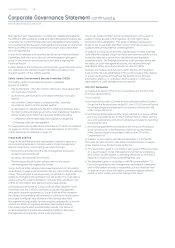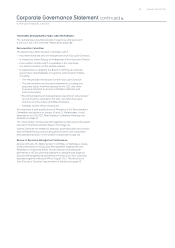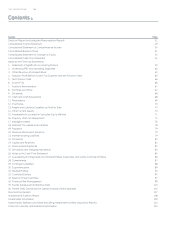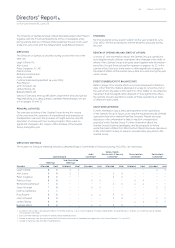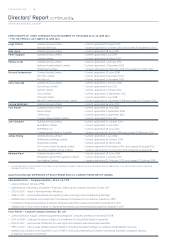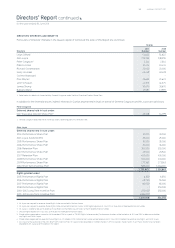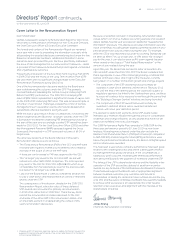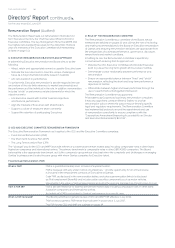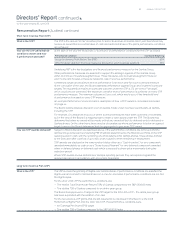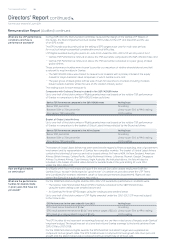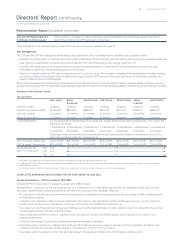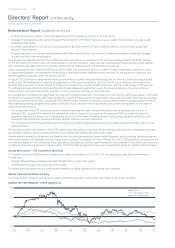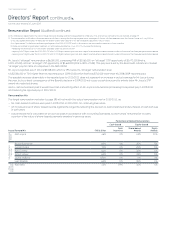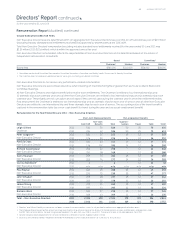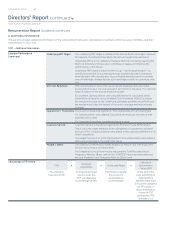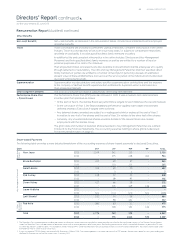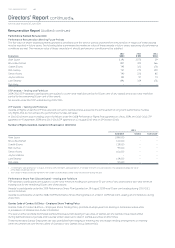Qantas 2011 Annual Report Download - page 38
Download and view the complete annual report
Please find page 38 of the 2011 Qantas annual report below. You can navigate through the pages in the report by either clicking on the pages listed below, or by using the keyword search tool below to find specific information within the annual report.
THE QANTAS GROUP 36
for the year ended 30 June 2011
Directors’ Report continued
The Remuneration Report sets out remuneration information for
Non-Executive Directors, the Chief Executive Ofcer (CEO) and
Executive Committee. The Key Management Personnel (KMP) and
ve highest remunerated Executives for the / nancial
year are members of the Executive Committee (full membership
is listed on page ).
EXECUTIVE REMUNERATION OBJECTIVES AND APPROACH
In determining Executive remuneration the Board aims to do the
following:
— Attract, retain and appropriately reward a capable Executive team
— Motivate the Executive team to meet the unique challenges it
faces as a major international airline based in Australia
— Link remuneration to performance
To achieve this, Executive remuneration is set with regard to the size
and nature of the role (with reference to market benchmarks) and
the performance of the individual in the role. In addition, remuneration
includes “at risk” or performance related elements for which the
objectives are to:
— Link Executive reward with Qantas’ business objectives
and nancial performance
— Align the interests of Executives with shareholders
— Support a culture of employee share ownership
— Support the retention of participating Executives
ROLE OF THE REMUNERATION COMMITTEE
The Remuneration Committee (a committee of the Board, whose
members are detailed on pages and ) has the role of reviewing
and making recommendations to the Board on Executive remuneration
at Qantas and ensuring remuneration decisions are appropriate from
the perspectives of business performance, governance, disclosure,
reward levels and market conditions.
In fullling its role, the Remuneration Committee is specically
concerned with ensuring that its approach will:
— Motivate the CEO, Executive Committee and broader Executive
team to pursue the long-term growth and success of Qantas
— Demonstrate a clear relationship between performance and
remuneration
— Ensure an appropriate balance between “xed” and “at risk”
remuneration, reecting the short and long-term performance
objectives of Qantas
— Differentiate between higher and lower performers through the
use of a performance management framework
The Remuneration Committee has appointed
PricewaterhouseCoopers as its primary remuneration consultant.
It has also appointed Johnson Winter & Slattery to provide
remuneration advice where this advice may be linked to specic
legal and regulatory requirements. The Remuneration Committee
has implemented protocols around the appointment and use
of remuneration consultants to ensure compliance with the
“Corporations Amendment (Improving Accountability on Director
and Executive Remuneration) Bill ”.
Remuneration Report (Audited)
CEO AND EXECUTIVE COMMITTEE REMUNERATION FRAMEWORK
The Executive Remuneration Framework as it applies to the CEO and the Executive Committee comprises:
— Fixed Annual Remuneration (FAR)
— The Short Term Incentive Plan (STIP)
— The Long Term Incentive Plan (LTIP)
The “at target” pay for the CEO and KMP is set with reference to external benchmark market data including comparable roles in other listed
Australian companies and international airlines. The primary benchmark is comparable roles in other S&P/ASX companies. The Board
believes this is the appropriate benchmark, as it is the comparator group whose roles best mirror the complexity and challenges in managing
Qantas’ businesses and is also the peer group with whom Qantas competes for Executive talent.
Fixed Annual Remuneration (FAR)
What is FAR? FAR is a guaranteed salary level, inclusive of superannuation.
FAR is reviewed annually under normal circumstances – and the opportunity for an annual review
is included in the employment contracts of Executives at Qantas.
Cash FAR, as disclosed in the remuneration tables, excludes superannuation (which is disclosed
as Post-employment Benets) and includes salary sacrice components such as motor vehicles.
Movements in the value of annual leave balances during the year are disclosed as Annual Leave Accrual.
How is FAR set? FAR is set with reference to external benchmark market data including comparable roles in other listed
Australian companies and international airlines.
An individual’s FAR is not related to Qantas’ performance in a specic year.
When is FAR reviewed? The Board performed a general review of CEO and KMP FAR effective July .
This followed a general FAR freeze that had been in place since July .
The FAR for the CEO and KMP are outlined on page .


